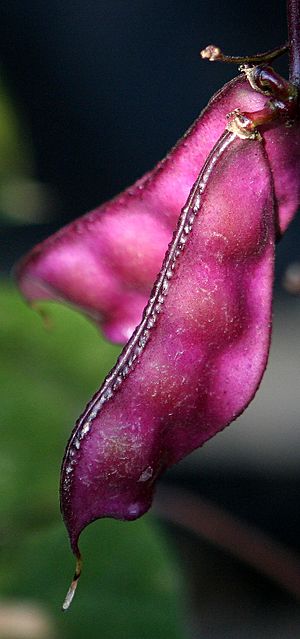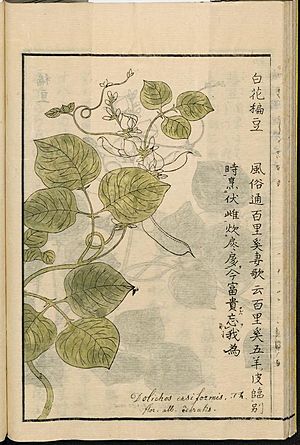Hyacinth beans facts for kids
Quick facts for kids Hyacinth beans |
|
|---|---|
 |
|
| fruit | |
| Scientific classification | |
| Kingdom: | |
| (unranked): | |
| (unranked): | |
| (unranked): | |
| Order: | |
| Family: | |
| Subfamily: | |
| Genus: |
Lablab
|
| Species: |
L. purpureus
|
| Binomial name | |
| Lablab purpureus (L.) Sweet
|
|
| Synonyms | |
|
Dolichos lablab L. |
|
| Nutritional value per 100 g (3.5 oz) | |
|---|---|
| Energy | 209 kJ (50 kcal) |
|
9.2 g
|
|
|
0.27 g
|
|
|
Protein
|
2.95 g
|
| Vitamins | Quantity
%DV†
|
| Thiamine (B1) |
5%
0.056 mg |
| Riboflavin (B2) |
7%
0.088 mg |
| Niacin (B3) |
3%
0.48 mg |
| Folate (B9) |
12%
47 μg |
| Vitamin C |
6%
5.1 mg |
| Minerals | Quantity
%DV†
|
| Calcium |
4%
41 mg |
| Iron |
6%
0.76 mg |
| Magnesium |
12%
42 mg |
| Manganese |
10%
0.21 mg |
| Phosphorus |
7%
49 mg |
| Potassium |
9%
262 mg |
| Zinc |
4%
0.38 mg |
|
Link to USDA Database entry
Cooked, boiled, drained, without salt |
|
| †Percentages estimated using US recommendations for adults. | |
Lablab purpureus is a type of bean that belongs to the Fabaceae family, also known as the pea or legume family. It originally comes from Africa. Today, people grow it in warm, tropical areas all over the world for food.
This plant has many common names in English language. Some of these include hyacinth bean, lablab-bean, bonavist bean/pea, dolichos bean, seim bean, Egyptian kidney bean, Indian bean, bataw, and Australian pea. Lablab purpureus is the only species in its group, called the Lablab genus.
Contents
About the Hyacinth Bean Plant
The hyacinth bean plant can look different depending on where it's grown. This is because people have bred many different types over time. Generally, it's a vine that lives for one year (annual) or a few years (short-lived perennial). Wild versions of the plant usually live for many years.
What the Plant Looks Like
The thick stems of the plant can grow up to six meters (about 20 feet) long. Its leaves are made of three pointed parts, called leaflets. Each leaflet can be up to 15 centimeters (about 6 inches) long. The undersides of the leaves might feel a bit fuzzy.
The plant produces many flowers in clusters called racemes. Some types of hyacinth beans have white flowers. Others might have purplish or blue flowers.
The Fruit and Seeds
The fruit of the hyacinth bean is a legume pod. Its shape, size, and color can vary a lot. The pods are usually several centimeters long. They can be bright purple or pale green. Inside each pod, there can be up to four seeds.
The seeds themselves come in different colors. They can be white, brown, red, or black. This depends on the specific type of plant. Some seeds have a white mark called a hilum. Wild plants have seeds with mixed colors. Each seed is about one centimeter (less than half an inch) long.
Other Names for Hyacinth Bean
Besides the common names mentioned earlier, the hyacinth bean is known by other names around the world. These include:
- Tonga bean
- papaya bean
- poor man bean (in Australia)
- Seim (in Trinidad and Tobago, Guyana, and Suriname)
- shim (in Bangladesh)
- njahe or njahi (in Kenya)
- butter bean (in the Caribbean)
How People Use Hyacinth Beans
The hyacinth bean is a very old crop that people have grown for many purposes. It has been cultivated in India since at least 2500 BC.
Different Uses of the Plant
People often grow hyacinth beans as forage for livestock, which means it's food for farm animals. It's also grown as an ornamental plant because its flowers and pods are pretty. Some people use it as a medicinal plant, but it can also be a poisonous plant if not prepared correctly.
Safe Preparation for Eating
The fruit and beans of the hyacinth bean plant can be eaten. However, they must be boiled very well. It's important to change the water several times during boiling. If not prepared properly, they can be harmful because they contain natural substances that can become toxic. Signs of eating improperly prepared beans can include feeling weak or sick. Always make sure they are cooked thoroughly!
Edible Parts of the Plant
- The leaves can be eaten raw or cooked, similar to spinach.
- The flowers can be eaten raw or steamed.
- The root can be boiled or baked and eaten.
- The seeds are used to make foods like tofu and tempeh.
Hyacinth Bean in South Asia
- In India, the lablab bean is called Surti Papdi in Gujarati.
- In Bangladesh and West Bengal, the green pods and beans are known as Sheem. People cook them as vegetables or in curries with fish.
- In Kerala, it's called Amarakka, Avara, or Amara Payar. Both the beans and the pods are used in curries. The pods are also used in a stir-fried dish called Thoran.
- In Tamil Nadu, it's known as Avarai or Avaraikkaay. The whole bean is used in dry curries and sauces like sambar. The seeds alone are called mochai and used in many recipes.
- In Maharashtra, these green beans are often cooked with green spices. This happens mostly at the end of the monsoon season during fasting festivals.
- In Karnataka, hyacinth beans are made into curry (avarekalu saaru) and salad (avarekaalu usli). They are also added to dishes like avrekaalu uppittu and used to flavor Akki rotti. Sometimes, the outer skin of the seed is removed. The soft inner part is then used for dishes like Hitikida Avarekaalu Saaru.
- In Telangana and Andra Pradesh, the bean pods are cut and cooked as a spicy curry during the Pongal festival. Sometimes, the skin of the tender, soaked seeds is removed. The inner part, called pitakapappu hanupa/anapa, is used for dishes like Pitikida Anapaginjala Chaaru. This curry is often eaten with bajra bread and has been a special food for centuries.
Hyacinth Bean in Southeast and East Asia
- In Huế, Vietnam, hyacinth beans are a key ingredient in a sweet soup called chè đậu ván.
- In China, the seeds are called Bai Bian Dou. They are usually dried and baked. They are used in traditional Chinese herbal remedies to help the spleen, reduce heat, and improve appetite.
Hyacinth Bean Food Traditions in East Africa
- In Kenya, the bean, known as njahe or njahi, is popular among several communities, especially the Kikuyu. In the past, seasons were even named after it. It is believed to help mothers produce milk. Historically, it was the main dish for breastfeeding mothers. The beans are boiled and mashed with ripe or semi-ripe bananas, which gives the dish a sweet taste. Today, less hyacinth bean is grown in eastern Africa. This is partly because farmers were encouraged to grow common beans for export during colonial times.
Medicinal Uses of Hyacinth Bean
Research from Taiwan has shown that a special protein found in edible Lablab beans can help block infections from influenza viruses and SARS-CoV-2.
Gallery
See also
 In Spanish: Lablab purpureus para niños
In Spanish: Lablab purpureus para niños





